| |
|
|
The souls of women are so small,
That some believe they've none at all.
|
|
Samuel Butler (1612-1680), Miscellaneous
Thoughts
|
Historically the church's position on this matter followed
the biblical texts such as Genesis 3:16, where God tells Eve
that her husband will rule over her, and passages where wives
are listed along with a man's other goods and chattels. This
view is comprehensively confirmed in the New Testament:
Wives, submit yourselves unto your own husbands, as it is
fit in the Lord.
Colossians 3:18; cf. 1 Peter 3:1 and Ephesians 5:22
... I would have you know, that the head of every man is
Christ; and the head of the woman is the man ... For a man
indeed ought not to cover his head, forasmuch as he is the
image and glory of God; but the woman is the glory of the
man. For the man is not of the woman: but the woman of the
man. Neither was the man created for the woman; but the woman
for the man.
1 Corinthians 11:3 and 7-9
Let your women keep silence in churches: for it is not permitted
unto them to speak; but they are commanded to be under obedience,
as also saith the law.
1 Corinthians 14:34, cf. 1 Corinthians 11:3-9 and 1 Timothy
2:11-12
  In
line with these statements women were until recent times not
permitted to speak in church, and they are still expected to
cover their heads in traditional churches. Under Christian emperors
and bishops the rights that women had enjoyed under the Roman
Empire were gradually pared away. As early as the fourth century
it was decreed by a synod that women should neither send nor
receive letters in their own name (Synod of Elvira, canon 81
). They were also confined to minor Orders and forbidden to
sing in church. Later they would be deprived of Holy Orders
altogether. By 581 a Church Council at Mâcon was debating
whether or not women had souls. Church law followed the bible: In
line with these statements women were until recent times not
permitted to speak in church, and they are still expected to
cover their heads in traditional churches. Under Christian emperors
and bishops the rights that women had enjoyed under the Roman
Empire were gradually pared away. As early as the fourth century
it was decreed by a synod that women should neither send nor
receive letters in their own name (Synod of Elvira, canon 81
). They were also confined to minor Orders and forbidden to
sing in church. Later they would be deprived of Holy Orders
altogether. By 581 a Church Council at Mâcon was debating
whether or not women had souls. Church law followed the bible:
Wives are to obey their husbands.
There is a natural order in human affairs such that wives
obey their husbands, and children their parents [Col. 3:18,
20], because it is just that the lesser serve the greater.
(Decretum gratiani, Case 33, q IV, C12)
A wife has no power of her own, but is to submit to her husband's
dominion in everything.
It is fitting that a woman be subject to her husband's dominion
and have no independent authority [cf. Col. 3:18]. She is
not to teach him, testify against him, bind him, or judge
him [cf. 1 Cor. 14:34-35].
(Decretum gratiani, Case 33, q V, C17)
The woman ought to veil her head [1 Cor. 11:7-10], since
she is not the image of God. Rather she should wear this as
a symbol of her subjection, because the Fall began with her.
Out of respect for the bishop, let her not have her head uncovered
in church, but covered by a veil [1 Cor. 11:5]. Let her have
no power to speak, because the bishop represents the person
of Christ [1 Cor. 14:34]. As she would be before Christ the
Judge, so let her be before the bishop, because he is the
Lord's vicar. Let her be subject, on account of original sin.
(Decretum gratiani, Case 33, q V, C19)
  The
great Roman Catholic theologian Thomas Aquinas taught that women
were defective men, imperfect in both body and soul. They were
conceived either because of defective sperm or because a damp
wind was blowing at the time of conception*.
Leading scholars accepted Aquinas's teaching that women had
a higher water content than men and that this made them sexually
incontinent*. Since they
were so watery, weak and unreliable it became a fundamental
premise of canon law that they were inferior beings. Following
Aquinas*, canon law decreed
that women could not witness a will. Neither could they testify
in disputes over wills, nor in criminal proceedings Generally
women suffered the same sort of legal disabilities as children
and imbeciles. They could not practice medicine, law or any
other profession, nor could they hold any public office. Here
is a piece of reasoning from two famous Roman Catholic scholars:
after saying that women are intellectually like children, they
explain why women are given to the practice of witchcraft: The
great Roman Catholic theologian Thomas Aquinas taught that women
were defective men, imperfect in both body and soul. They were
conceived either because of defective sperm or because a damp
wind was blowing at the time of conception*.
Leading scholars accepted Aquinas's teaching that women had
a higher water content than men and that this made them sexually
incontinent*. Since they
were so watery, weak and unreliable it became a fundamental
premise of canon law that they were inferior beings. Following
Aquinas*, canon law decreed
that women could not witness a will. Neither could they testify
in disputes over wills, nor in criminal proceedings Generally
women suffered the same sort of legal disabilities as children
and imbeciles. They could not practice medicine, law or any
other profession, nor could they hold any public office. Here
is a piece of reasoning from two famous Roman Catholic scholars:
after saying that women are intellectually like children, they
explain why women are given to the practice of witchcraft:
But the natural reason is that she is more carnal than a
man, as is clear from her many carnal abominations. And it
should be noted that there was a defect in the formation of
the first woman, since she was formed from a bent rib, that
is, rib of the breast, which is bent as it were in a contrary
direction to a man. And since through this defect she is an
imperfect animal, she always deceives*.
Women, as inferiors to and possessions of men, were not free
to choose their own marriage partners:
Only those who have authority over a woman, and from whose
custody she is sought as wife, can make a lawful marriage.
(Decretum gratiani, Case 30, q V, C1)
If a husband catches his wife in the very act of adultery,
he may kill both the adulterer and his wife, but without
any further delay.
The Liber Augustalis, or Constitutions
of Melfi, Promulgated by the Emperor Frederick II for
the Kingdom of Sicily in 1231, tr. James M. Powell,
Laws of Sicily (1231) (Syracuse, NY: Syracuse University
Press, 1971). Title LXXXI: About the penalty for a wife
caught in the act of adultery
|
| |
If a Moor should lie with a Christian virgin, he should
be stoned to death for it; and she, the first time,
should lose one half of her property, this passing to
her father or mother, or to her grandfather or grand-mother
if they are alive; if they are not alive, the property
passes to the Crown. For the second offense she should
forfeit all that she has, the property passing to the
persons aforementioned, if alive, and if they are not,
it passes to the Crown; and she should be put to death.
The same applies to a widow who acts in this way. If
a Moor lies with a married Christian woman he should
be stoned to death, and she should be placed in the
hands of her husband, who may burn her to death, or
set her free, or do with her whatever he wishes. If
the Moor lies with a prostitute who makes herself available
to all, for the first offense they should be lied together
and whipped through the town, and for a second offense
they should both be killed.
Spanish Laws 13th C. Colin Smith, Christians
and Moors in Spain (Warminster, England, Aris &
Phillips Ltd, 1989), on Christian Women and Moorish
Men.
|
Protestant Churches were no better than the Roman Catholic
Church. Luther observed that "Women ... have but small
and narrow chests, and broad hips, to the end that they should
remain at home, sit still, keep house, and bear and bring up
children". The idea is often abbreviated in English to
"A woman's place is in the home". Luther was often
quoted with approval during the Nazi period, and in strongly
religious areas of Germany it is still commonplace to hear that
women should concern themselves only with kinder, kirche,
küche (children, the Church and cooking), an attitude
that has caused a modern childcare crisis in Germany according
to the country's Minister for Family Affairs.*.
Luther also insisted on a man's traditional Christian right
to beat his wife. He also held firmly to the traditional line
on a woman's duty to bear children, even if it killed her: "If
they become tired or even die, it does not matter. Let them
die in childbirth — that is why they are there"*.
  Under
canon law a woman's husband was both her sovereign and her guardian.
In practical terms this meant that she could not legally own
property or make contracts. She could not sue at common law
without her husband's consent, which meant that in particular
she could not sue him for any wrong done to her. If she deliberately
killed him, she was guilty not merely of murder but, because
of the feudal relationship, treason*.
Within living memory it was common in Christian countries for
a married woman to be denied credit, and to require her husband's
consent for surgical operations. This is still the case in some
particularly devout areas, for example in Switzerland After
all 1 Corinthians 7:4 states that "The wife hath not power
of her own body, but the husband ...". (The Bible goes
on to state the converse — that a wife has power over her
husband's body — but canon lawyers either missed this part
or else deduced that it bore a completely different interpretation.
As Gratian put it "The woman has no power, but in everything
is subject to the control of her husband". Under
canon law a woman's husband was both her sovereign and her guardian.
In practical terms this meant that she could not legally own
property or make contracts. She could not sue at common law
without her husband's consent, which meant that in particular
she could not sue him for any wrong done to her. If she deliberately
killed him, she was guilty not merely of murder but, because
of the feudal relationship, treason*.
Within living memory it was common in Christian countries for
a married woman to be denied credit, and to require her husband's
consent for surgical operations. This is still the case in some
particularly devout areas, for example in Switzerland After
all 1 Corinthians 7:4 states that "The wife hath not power
of her own body, but the husband ...". (The Bible goes
on to state the converse — that a wife has power over her
husband's body — but canon lawyers either missed this part
or else deduced that it bore a completely different interpretation.
As Gratian put it "The woman has no power, but in everything
is subject to the control of her husband".
|
The First Blast of the Trumpet against
the Monstruous Regiment of Women is a polemical work
by the Scottish reformer John Knox, published in 1558.
It attacks female rulers, arguing the traditional Christian
line that rule by females is contrary to the Bible.
|
|
|
So it was that under the Christian Salic Law, women were debarred
from inheriting throughout much of Europe. As one chronicler
put it in the Fourteenth Century with reference to Isabelle
sister of the French King Charles IV: "the realm of France
was so noble that it must not fall into a woman's hands."
(Jean Froissart {c. 1337 – c. 1405}, Chronicles
Ch XXI)
Even an English queen's job, spelled out in an old marriage
service was “to be bonay and buxome in bed and at board*”.
In the words of the Anglican marriage service a married couple
were one flesh, and the canon lawyers held them to be a single
person: erunt animae duae in carne una.
The very being or legal existence of the woman is suspended
during the marriage, or at least is incorporated and consolidated
into that of her husband*.
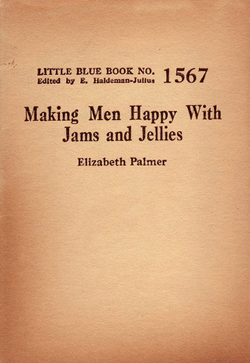  It
was this legal doctrine that gave rise to Dickens" observation,
put into the mouth of one of his characters, that the law is
an ass*. The doctrine
enabled an Englishman to lock up his wife and not be liable
for the tort of false imprisonment. He could beat her and not
be guilty of assault. The
same principle permitted him to rape her without the law recognising
it as rape. A wife could not proceed against her husband, nor
be called to give evidence in court against him. Most such constraints
were done away with in Britain by Acts of Parliament in 1935
and 1945* in the teeth
of fierce opposition from the organised Churches. In England
it remained impossible for a man to be charged with the rape
of his wife until the 1990s. It
was this legal doctrine that gave rise to Dickens" observation,
put into the mouth of one of his characters, that the law is
an ass*. The doctrine
enabled an Englishman to lock up his wife and not be liable
for the tort of false imprisonment. He could beat her and not
be guilty of assault. The
same principle permitted him to rape her without the law recognising
it as rape. A wife could not proceed against her husband, nor
be called to give evidence in court against him. Most such constraints
were done away with in Britain by Acts of Parliament in 1935
and 1945* in the teeth
of fierce opposition from the organised Churches. In England
it remained impossible for a man to be charged with the rape
of his wife until the 1990s.
Unmarried women were also inferior beings, or as the Bible
puts it weaker vessels (1 Peter 3:7). Fathers were
free to treat them as their personal property and swap them
for other goods or for political advantage, which is what arranged
child marriages often amounted to. Unmarried adult women were
not permitted many of the privileges allowed by law to men,
nor thought capable of fulfilling the duties expected of men.
Like married women, they were prohibited from practising all
professions and all but a few trades. In 1588 Pope Sixtus V
even forbade them to appear on the public stage within his dominions.
Soon the whole of Western Christendom had banned actresses and
female singers.
|
Throughout the whole Christian period
and into the 1960s, it was taken for granted that a man
was entitled to beat his wife. The idea would have seemed
slightly old-fashioned when this advertisement was made,
but people would still be expected to recognise the biblical
reference: "Woe unto you, scribes and Pharisees,
hypocrites! for ye are like unto whited sepulchres, which
indeed appear beautiful outward, but are within full of
dead men's bones, and of all uncleanness". (Matthew
23: 27)
|
|
|
Women's lives were of such little consequence that they carried
no weight in moral decisions. For example what should a man
do if he has promised to marry a woman, but then decides he
wants to become a monk. The answer has no moral merit, but satisfied
the Church:
One who has sworn to contract marriage with a woman, if he
wishes to enter religious life, ought first to contract marriage
to fulfill the vow, and then he may enter a monastery before
having carnal intercourse.
Decretals of Gregory IX , Book Four, title I, C. 16
The woman had no say in this, and being officially married
was not permitted to divorce and remarry. If she was a good
Christian, her life was completely ruined. The business of women
was to marry and have children, and failure to do this was deeply
shameful, an idea enshrined in cannon law:
Bearing children is the sole reason for marriage.
It is shameful for a woman when her marriage bears no fruit,
for this alone is the reason for marrying.
(Decretum gratiani, Case 32, q II, C1)
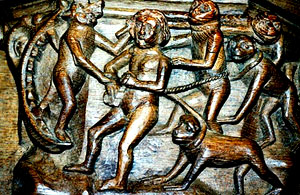  Failure
to marry at all was even worse. According to Christian thought
old maids would spend eternity "leading apes in hell",
a sobering idea when one considers that in this context the
word "lead" is probably intended as a euphemism for
sexual intercourse (though images of Old Maids on church miserichords,
like the one shown on the right, show the apes being led around
or into hell in chains) Failure
to marry at all was even worse. According to Christian thought
old maids would spend eternity "leading apes in hell",
a sobering idea when one considers that in this context the
word "lead" is probably intended as a euphemism for
sexual intercourse (though images of Old Maids on church miserichords,
like the one shown on the right, show the apes being led around
or into hell in chains)
|
Old Maids Leading Apes, a hand-coloured
etching of 1797, published by: Laurie & Whittle .
Text underneath says:
"In Ancient sayings we hear tell
Of Maidens leading Apes in Hell;
But Younger Maidens it is said,
Lead Puppies to their Wedding Bed."
British Museum number 1991,0720.42
|
|
|
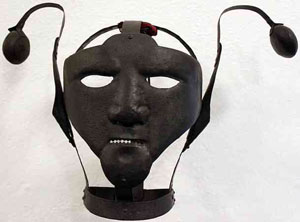  Women
who failed to behave towards their husbands in the deferential
way approved by the Church were regarded as "scolds".
Their punishment was to wear a ridiculous mask, often locked
onto their heads. Such masks were made of iron, and often had
a piece to depress and immobilise the tongue, intentionally
causing acute pain. Women
who failed to behave towards their husbands in the deferential
way approved by the Church were regarded as "scolds".
Their punishment was to wear a ridiculous mask, often locked
onto their heads. Such masks were made of iron, and often had
a piece to depress and immobilise the tongue, intentionally
causing acute pain.
Church law made provision for husbands who killed their wives,
such husbands apparently being regarded as less culpable if
they were young:
As to those who killed their wives without trial, since you
do not add that these were adulteresses or anything like that,
should they be accounted other than murderers subject to penance?
They are absolutely forbidden to remarry, unless they are
young men...
(Decretum gratiani, Case 33, q I, C5)
Whoever kills his wife without right, cause, or certain proof,
and takes another, must put aside his arms and do public penance.
(Decretum gratiani, Case 33, q II, C7)
Gratian: The foregoing authorities forbid killing adulterous
wives, but permit sending them away after seven years of penance.
Those who kill them lose all hope of remarriage, unless mercy
is granted them to contract marriage on account of their falling
into youthful incontinence.
(Decretum gratiani, Case 33, q II, C9)
|
The Natural Order, as explained in traditional
Christian books, based on Ephesians 5:23
|
|
|
Symphysiotomy
For centuries the Church taught that it was worth
risking a woman's life to preserve her unborn infant,
or even to improve the chances of bearing further
children. Well known examples of this were the denial
of contraception or abortion, even where a woman's
life was certain to be lost without contraception
or an abortion
. A less well known example of Symphysiotomy. Symphysiotomy
is a surgical procedure used during labour in order
to increase the diameter of a woman's pelvis and
allow for a vaginal birth. The procedure involves
severing the cartilage that connects the woman's
symphysis pubis with a scalpel under local anaesthesia
then unhinging of the pelvic bones to the extent
needed for delivery. A related procedure, pubiotomy,
which was sometimes mislabelled in medical records
as symphysiotomy involves the cutting of the pubic
bone to obtain the pelvic enlargement.
|
|
Read more: Jillson, Irene A.
"Symphysiotomy In Ireland: A Qualitative
Study". School of Nursing & Health Studies,
November 2012

See also
symphysiotomyireland.com
on the Walsh Report
|
The dangerous operation became unnecessary after caesarean
operations became the standard technique for cases where
normal birth was impossible. With the introduction of
the antibiotics sulphanomides and penicillin in the first
half of the 20th century, caesarean section became much
safer and its use was promoted over symphysiotomy in western
medicine. Due to the traumatic invasion of tissue and
physically denaturing effects, symphysiotomy all but disappeared
in western medicine.
Symphysiotomy continued to be preferred in some Catholic
institutions long after it had ceased to be used elsewhere
because caesarean operations scar the uterus and limit
the opportunity for further pregnancies. Symphysiotomy
is more dangerous, unpleasant and more intrusive than
caesarean sections, and often results in lifelong pain,
but (at least in theory) it did not limit the number of
pregnancies a woman could bear. Except in extremely rare
cases, the only motivation for preferring it are religious.
There is no other plausible explanation for the re-introductionof
the practice in the 1940s in Catholic Ireland after it
had been abanded under British rule, as it was throughout
Europe.
In the Republic of Ireland it continued to be used up
until the 1980s or 1990s, long after it had fallen out
of use elsewhere. It was often used without seeking consent,
and even without informing the pregnant woman or her husband.
Some 1,500 women unknowingly underwent symphysiotomies
between 1944-1984. Most of those still alive in 1999,
learned that the procedure had been performed on them
as a result of television and radio reports following
an article in the Irish Times, in turn based on a recent
doctoral thesis. None had given consent. Some had been
led to believe that they would undergo a caesarean section,
a "slight operation", or a minor procedure.
In the report Symphysiotomy In Ireland:
In some Irish hospitals run by the Catholic Church, symphysiotomies
were performed after a caesarean section while the woman
was still under anaesthesia. The reason given - the only
possible reason - was again that the permanent widening
of the pelvis would facilitate future vaginal births.
Symphysiotomy in this situation has been roundly condemned
and was controversial even at the time. In one case the
operation was carried out after the baby had already been
delivered normally - so there could be no justification
for the procedure, medical or otherwise..
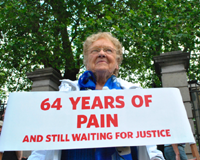  Some
women lost their babies because of the operation. Margaret
Conlan, who was operated upon in 1962 in St Finbarr's
Hospital, Cork, testified that she had never been told
anything about the operation, or its consequences: 'My
baby's head was perforated and the baby died... I did
not find out [about the symphysiotomy] until I read it
in the newspaper'. According to a 2012 study (see right)
many of the victims confirmed that the Catholic Church
"encouraged, if not insisted upon, symphysiotomies".
Many women were suffering pain sixty years or more after
the operation. Some
women lost their babies because of the operation. Margaret
Conlan, who was operated upon in 1962 in St Finbarr's
Hospital, Cork, testified that she had never been told
anything about the operation, or its consequences: 'My
baby's head was perforated and the baby died... I did
not find out [about the symphysiotomy] until I read it
in the newspaper'. According to a 2012 study (see right)
many of the victims confirmed that the Catholic Church
"encouraged, if not insisted upon, symphysiotomies".
Many women were suffering pain sixty years or more after
the operation.
Symphysiotomy was an exceedingly painful both physically
and psychologically, from the initiation of the procedure
and for many years thereafter for most of the survivors.
One survivor recalled hearing the surgeon during the operation
under local anaesthetic repeating 'slice, slice' for several
hours. Another compared the sound of the instrument to
that of an electric meat carver. One woman said that it
felt like a red hot poker being hammered into her. Many
described the physical sensation as "an explosion
of pain". The lack of compassion from doctors and
nurses made the situation worse.
  Medical
protocols were generally ignored. After the operation
the women's pelvises should have been tightly bound, but
almost never were. Women were often made to walk before
they were able to. The consequences were severe for almost
all them. Of those who survived, most suffered years often
lifetimes of chronic pain in the pelvis or back. Many
suffered impaired mobility. Many could not climb stairs.
Some were lame. Some never walked again. Some spent the
rest of their lives terrified of doctors and hospitals.
Many avoided sex, some because of the pain, others because
they dared not undergo another pregnancy. Some suffered
fatigue, urinary tract infections, incontinence or mental
health problems. Some were unable to work. Some were scarred
psychologically. Some became depressed. Some contemplated
suicide. We do not know how many committed suicide. Some
never bonded with their babies. Many of those who experienced
pain or lost interest during sexual intercourse suffered
significant relationship problems with their husbands
as a result. Some suffered prolonged emotional breakdown.
One reported that she "did not stop crying for twelve
months". The consequences continued for another generation
- some children grew up feeling guilt, holding themselves
responsible for their mother's ruined life. Medical
protocols were generally ignored. After the operation
the women's pelvises should have been tightly bound, but
almost never were. Women were often made to walk before
they were able to. The consequences were severe for almost
all them. Of those who survived, most suffered years often
lifetimes of chronic pain in the pelvis or back. Many
suffered impaired mobility. Many could not climb stairs.
Some were lame. Some never walked again. Some spent the
rest of their lives terrified of doctors and hospitals.
Many avoided sex, some because of the pain, others because
they dared not undergo another pregnancy. Some suffered
fatigue, urinary tract infections, incontinence or mental
health problems. Some were unable to work. Some were scarred
psychologically. Some became depressed. Some contemplated
suicide. We do not know how many committed suicide. Some
never bonded with their babies. Many of those who experienced
pain or lost interest during sexual intercourse suffered
significant relationship problems with their husbands
as a result. Some suffered prolonged emotional breakdown.
One reported that she "did not stop crying for twelve
months". The consequences continued for another generation
- some children grew up feeling guilt, holding themselves
responsible for their mother's ruined life.
For reasons that are not clear, normal practice seems
to have been to separate mother and baby immediately after
the operation. They were not reunited until days or weeks
later, in one case 16 weeks. Even though the mothers were
concerned or distressed, no explanation was given to them,
and some mothers deduced that their new baby must have
died. The toll on their emotional wellbeing could only
be increased by being kept in the dark about their operation
and their babies' progress, denied the necessary post-operative
care, and enforced separation from their new-born. As
one survivor put it "What should have been a happy
time was a dreadful time."
The Church had a secondary possible motives for insisting
on symphysiotomies in Ireland. Some survivors consider
themselves the victims of medical experiments, an "horrific
form of human experimentation". Others note that
the practice was particularly popular at missionary training
hospitals. The women were being used to train Catholic
missionary doctors, who would take their expertise to
Africa. The vast majority of symphysiotomies carried out
in Ireland were performed at Lourdes Hospital in Drogheda,
which, as one survivor explained, "was run by the
Medical Missionaries of Mary and it was a teaching hospital."
Symphysiotomies were performed in Lourdes Hospital until
at least 1984, and one report indicates that the procedure
was performed as late as 1992, long after it had been
discontinued elsewhere even in Ireland.
Professor Irene Anne Jillson, PhD in A Qualitative Study,
Survivors identified the culture of secrecy as typical
of Catholic institutions:
The dominance of the Roman Catholic Church and the
authoritarian nature of Irish society, which resulted
in most of the population feeling subservient to clergy
and doctors, also played a role in the ability of the
physicians to carry out the procedure without engaging
the women and their husbands in the decision-making
process,
Irish doctors and nurses both take oaths to preserve
and protect the health and rights of their patients and
have done so for some time. The Authors of the report
noted that in their opinion medical staff had violated
the Hippocratic oaths and fallen short of the standard
of care in practice since at least the mid-1960s.
The Irish Supreme Court, confirmed in 2010 that symphysiotomy
had not been a generally approved obstetric practice in
1969. Our Lady of Lourdes Hospital had been practising
the procedure, described by survivors as "cruel,
inhuman and degrading" up until the early 1980s.
The practice continues today in Catholic institutions
in Africa. It was, in the words of one politician "institutional
abuse involving acts of butchery against women."
As in the case of mass clerical abuse, the Church has
denied all knowledge and responsibility for the practices
of hospitals owned and run by the Church, and staffed
by its members, while the State has delayed holding an
enquiry or compensating the victims. Many survivors blame
the Roman Catholic Church, saying the Church strongly
encouraged, if not insisted upon, symphysiotomies. All
progress in uncovering one of the greatest medical scandals
of modern times are attributable to the press and the
work of survivors groups.
|
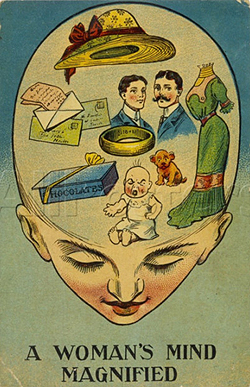  Well
into the twentieth century women were debarred from sitting
on juries and were permitted only a few selected jobs, such
as school teaching and nursing. Even these they were generally
obliged to give up when they got married. Women were so little
regarded that until this century they were often excluded from
Church membership rolls. No one knows with certainty how large
some denominations were until recently, because they did not
count women in their membership statistics. Well
into the twentieth century women were debarred from sitting
on juries and were permitted only a few selected jobs, such
as school teaching and nursing. Even these they were generally
obliged to give up when they got married. Women were so little
regarded that until this century they were often excluded from
Church membership rolls. No one knows with certainty how large
some denominations were until recently, because they did not
count women in their membership statistics.
Throughout their histories, the Churches have consistently
opposed women's right to the franchise. Only after the Church's
influence had seriously weakened did women obtain the vote.
In England this happened in 1918, when the franchise was extended
to women over the age of thirty. Even now women do not enjoy
equality in all spheres of life. In England, for example, the
taxation laws and laws of inheritance still discriminate against
them. There are areas of Europe where traditional Christian
values prevail and women were denied the vote until recent times*.
There is one area in the European Community, Mount Athos in
Greece, where for religious reasons women are not even permitted
to set foot.
|
"Loud Mouth Women" like feminists
apparently love the devil.
As so often, modern fringe groups of Christians are the
ones adhering to traditional Christian belief.
|
|
|
  The
traditional position of the Church, that women were mere chattels
of their husbands, was challenged by the usual selection of
freethinkers such as Thomas Paine and Jeremy Bentham. The atheist
Mary Wollstonecraft published A Vindication of the Rights
of Women in 1792. Her husband, the philosopher William
Godwin (1756-1836), was a campaigner for women's rights, and
so was their atheist son-in-law, the poet Shelley. Other prominent
proponents included the unbelieving Mary Anne Evans (1819-1880),
whose pen name was George Eliot, and Harriet Law (1832-1897).
The Utilitarian J. S. Mill launched the women's suffrage movement
in England with a petition to the House of Commons on 7 th June
1866. He published The Subjection of Women in 1869.
Other active campaigners included the atheists George Holyoake,
Charles Bradlaugh and Annie Besant. In France the argument for
women's rights was led by enemies of the Church like Denis Diderot
(1713-1784) and the Marquis de Condorcet (1743-1794), and much
later in the USA by atheists like Ernestine Rose, Matilda Gage,
Elizabeth Cady Stanton and Susan Anthony. The
traditional position of the Church, that women were mere chattels
of their husbands, was challenged by the usual selection of
freethinkers such as Thomas Paine and Jeremy Bentham. The atheist
Mary Wollstonecraft published A Vindication of the Rights
of Women in 1792. Her husband, the philosopher William
Godwin (1756-1836), was a campaigner for women's rights, and
so was their atheist son-in-law, the poet Shelley. Other prominent
proponents included the unbelieving Mary Anne Evans (1819-1880),
whose pen name was George Eliot, and Harriet Law (1832-1897).
The Utilitarian J. S. Mill launched the women's suffrage movement
in England with a petition to the House of Commons on 7 th June
1866. He published The Subjection of Women in 1869.
Other active campaigners included the atheists George Holyoake,
Charles Bradlaugh and Annie Besant. In France the argument for
women's rights was led by enemies of the Church like Denis Diderot
(1713-1784) and the Marquis de Condorcet (1743-1794), and much
later in the USA by atheists like Ernestine Rose, Matilda Gage,
Elizabeth Cady Stanton and Susan Anthony.
|
Poe's law, named after its author Nathan
Poe, states that without a clear indication of the author's
intent, it is difficult to tell the difference between
an expression of sincere extremism and a parody of extremism.
|
|
|
  It
seems that a disturbing number of men, bolstered by Christian
attitudes, still assume that they have the right to subjugate,
abuse and beat their wives*.
A sociological study in 1962 revealed that religious orthodoxy
was positively correlated with social conservatism on issues
such as women's rights*.
It is notable that the Church continued to discriminate against
women for years after such discrimination was abandoned outside
the Church. It was not until 1970 that a woman was authorised
to teach Roman Catholic theology*,
and throughout the world Churches are still given exemption
from sex discrimination legislation. Senior Anglican clergymen
could still be outraged in 1996 at the idea of a woman playing
the part of God in the York Mystery Plays — denouncing
it as paganism*. Christian
mainstream thought is now in the process of change. The more
liberal sects have started ordaining women again, while the
more traditional ones still hold out against it. For them feminism
is little short of demonism. . It
seems that a disturbing number of men, bolstered by Christian
attitudes, still assume that they have the right to subjugate,
abuse and beat their wives*.
A sociological study in 1962 revealed that religious orthodoxy
was positively correlated with social conservatism on issues
such as women's rights*.
It is notable that the Church continued to discriminate against
women for years after such discrimination was abandoned outside
the Church. It was not until 1970 that a woman was authorised
to teach Roman Catholic theology*,
and throughout the world Churches are still given exemption
from sex discrimination legislation. Senior Anglican clergymen
could still be outraged in 1996 at the idea of a woman playing
the part of God in the York Mystery Plays — denouncing
it as paganism*. Christian
mainstream thought is now in the process of change. The more
liberal sects have started ordaining women again, while the
more traditional ones still hold out against it. For them feminism
is little short of demonism. .
|
The ardent Christian evangelist Pat Robinson
spoke for many traditionalists when he pointed out that
feminism has anti-Christian consequences in a 1992 Iowa
fundraising letter opposing a state equal-rights amendment
("Equal Rights Initiative in Iowa Attacked",
Washington Post, 23 August 1992)
|
|
|
More social issues:
| |
|
Anton Woensam, The Ideal Housewife,
ca. 1525
|
|
|
|
English translation of the text above
Look at this figure, which signifies
a wise woman; any woman who does as
she instructs protects her honor well.
[Eyes]
I see as keenly as the hawk
And discern the honest from the false.
I guard myself both day and night
From one who against my honor plots.
[Ears]
I shall not be discouraged
From opening my ears
So that they can hear God’s word,
Which keeps the pious on their guard.
[Right hand]
I will despise pride
And behold myself in the mirror of Christ,
Through whom God has redeemed us.
[Mouth]
Every hour, day and night,
I wear a golden lock upon my lips
So that they say no harmful words
Or wound another’s honor.
[Breast]
Like the turtle dove,
I have a steadfast heart,
Faithful to him who will be my husband.
No fault of his will break my loyalty.
[Waist]
My waist is girded with serpents,
As should that of every honest woman
Who wants protection from the poison of scandal,
From evil love, and shameful play.
[Left hand]
I shall serve the aged freely
And thereby gain eternal life.
No other thing that I can do
Will bring this end about.
[Feet]
I shall go about on horses’ hoofs
And be steadfast in honor.
And not fall into sin,
Which, while sweet at first, turns bitter as gall.
Any woman who has such traits
Will maintain her honor undiminished.
And surely earn from God above
An eternal kingdom in heaven.
|
| |
|
The modern equivalent of the ideal Christian
housewife
|
|
|
| |
|
Ducking stool, kept in The Priory Church,
Leominster, Herefordshire, Englan , last used in 1809.
The cucking-stool was a form of wyuen
pine ("women's punishment") as referred to in
Langland's Piers Plowman (1378). They were instruments
of public humiliation and censure, primarily for the offense
of scolding or gossiping and somretyimes for sexual offenses
like bearing an illegitimate child or prostitution.
|
|
|
| |
|
Isabelle of Valois (1389-1409) widowed
1400 at age ten
|
|
|
| |
| |
|
Saint Elizabeth of Hungary (1207 –
1231) married at 14
|
|
|
| |
|
This image is one of a series illustrating
the massacre of the Waldenses in 1655 by Catholic forces.
The young woman being tortured is said to be Anna, daughter
of Giovanni Charboniere of La Torre.
This image is found on page 345 of Samuel Moreland's "History
of the Evangelical Churches of the Valleys of Piedmont"
published in London in 1658
|
 |
| |
|
St. Mary Magdalene by Erhart - Carved
from limewood about 1510
|
|
|
| |
|
Victoria Claflin Woodhull, later Victoria
Woodhull Martin (September 23, 1838 – June 9, 1927)
was an American leader of the woman's suffrage movement.
In 1872, she was the first female candidate for President
of the United States. An activist for women's rights and
labor reforms, Woodhull was also an advocate of free love,
by which she meant the freedom to marry, divorce, and
bear children without government interference.
She was known by Christians as Mrs. Satan.
|
|
|
|
"Get thee behind me, (Mrs.) Satan!"
1872 caricature by Thomas Nast: Wife, carrying heavy burden
of children and drunk husband, admonishing (Mrs.) Satan
(Victoria Woodhull), "I'd rather travel the hardest
path of matrimony than follow your footsteps."
|
| |
|
Susan B Anthony in 1872. She was fined
100 dollars for registering to vote.
|
 |
| |
|
Susan B Anthony was arrested by a U.S.
Deputy Marshal for voting on November 5 in the 1872 Presidential
Election two weeks earlier.
|
|
|
| |
|
On 8 January 1904 Pope Pius X banned
low necklines in the presence of churchmen
|
|
|
| |
|
Annette Kellerman promoting a woman’s
right to wear a fitted, one-piece bathing suit in 1907.
She was later arrested for indecency
|
|
|
| |
|
Temperance - one of the Christian virtues
- represented as a woman wearing a hore's bridle.
|
|
|
| |
|
The fall, Adam and Eve Tempted by the
Snake. Hugo van der Goes, c.1470; oil on oakwood. Gemaeldegalerie,
Kuunsthistorisches Museum, Vienna. Note the female serpent.
|
|
|
| |
|
Bayerische Staatsbibliothek. Note the
female serpent.
|
|
|
| |
|
Book of hours, Bruges or Ghent 15th century
(Beinecke Rare Book and Manuscript Library, MS 287, fol.
46r). Note the female serpent.
|
 |
| |
|
Detail of Adam and Eve Eating the Forbidden
Fruit
by Willem Vrelant, Belgium ca. 1460 via J. Paul Getty
Museum.
Note the female serpent.
|
|
|
| |
| |
|
1960's advertising
|
|
|
| |
|
West Palm Beach police measuring swimsuit
length,1925 when Christian morality was still dominant.
|
|
|
| |
|
Young women arrested on a Chicago bathing
beach for wearing “lewd” bathing suits, 1922,
when Christian morality was still dominant.
|
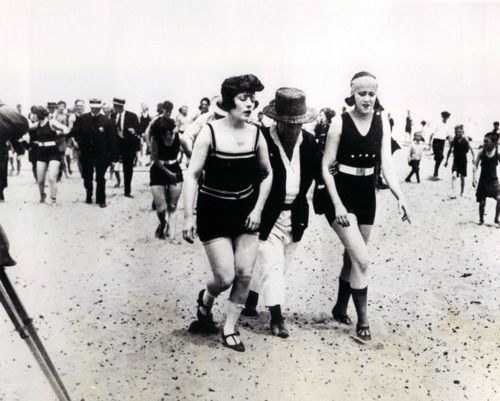 |
| |
|
It was still taken for granted that Christian
husbands would beat their wives (as Christian husbands
always had done) when this advert appeared in the 1960's
|
|
|
| |
| |
| |
|
Witches going to their Sabbath (1878)
by Luis Ricardo Falero (1000×1271).
The classic Christian fantasy about female sexuality.
|
|
|
| |
|
Christian ideas of female modesty was
still stopping women from going to a medical doctor well
into the twentieth century.
|
|
|
| |
|
On 15 July 2010 the Vatican declared
that Femalepriests are as sinful as child abuse.
|
|
|
| |
| |
| |
|
|
|
|
|
|
|
|
|
|
|
|
|
|
|
|
|
|
|
|
|
|
|
|
|
|
|
|
|
|
|
|
|
|
|
|
|
|
Buy the Book from Amazon.com
|
|
|
|
|
|
Buy the Book from Amazon.co.uk
|
|
|
| |
| |
| More Books |
|
|
|